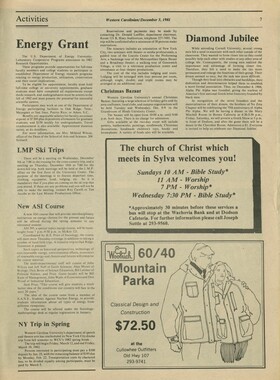Western Carolina University (21)
View all
- Canton Champion Fibre Company (2308)
- Cherokee Traditions (291)
- Civil War in Southern Appalachia (165)
- Craft Revival (1942)
- George Masa Collection (137)
- Great Smoky Mountains - A Park for America (3080)
- Highlights from Western Carolina University (422)
- Horace Kephart (998)
- Journeys Through Jackson (159)
- LGBTQIA+ Archive of Jackson County (89)
- Oral Histories of Western North Carolina (318)
- Picturing Appalachia (6617)
- Stories of Mountain Folk (413)
- Travel Western North Carolina (153)
- Western Carolina University Fine Art Museum Vitreograph Collection (129)
- Western Carolina University Herbarium (92)
- Western Carolina University: Making Memories (738)
- Western Carolina University Publications (2491)
- Western Carolina University Restricted Electronic Theses and Dissertations (146)
- Western North Carolina Regional Maps (71)
- World War II in Southern Appalachia (131)
University of North Carolina Asheville (6)
View all
- Allanstand Cottage Industries (62)
- Appalachian National Park Association (53)
- Bennett, Kelly, 1890-1974 (1463)
- Berry, Walter (76)
- Brasstown Carvers (40)
- Carver, George Washington, 1864?-1943 (26)
- Cathey, Joseph, 1803-1874 (1)
- Champion Fibre Company (233)
- Champion Paper and Fibre Company (297)
- Cherokee Indian Fair Association (16)
- Cherokee Language Program (22)
- Crowe, Amanda (40)
- Edmonston, Thomas Benton, 1842-1907 (7)
- Ensley, A. L. (Abraham Lincoln), 1865-1948 (275)
- Fromer, Irving Rhodes, 1913-1994 (70)
- George Butz (BFS 1907) (46)
- Goodrich, Frances Louisa (120)
- Grant, George Alexander, 1891-1964 (96)
- Heard, Marian Gladys (60)
- Kephart, Calvin, 1883-1969 (15)
- Kephart, Horace, 1862-1931 (313)
- Kephart, Laura, 1862-1954 (91)
- Laney, Gideon Thomas, 1889-1976 (439)
- Masa, George, 1881-1933 (61)
- McElhinney, William Julian, 1896-1953 (44)
- Niggli, Josephina, 1910-1983 (10)
- North Carolina Park Commission (105)
- Osborne, Kezia Stradley (9)
- Owens, Samuel Robert, 1918-1995 (11)
- Penland Weavers and Potters (36)
- Roberts, Vivienne (15)
- Roth, Albert, 1890-1974 (142)
- Schenck, Carl Alwin, 1868-1955 (1)
- Sherrill's Photography Studio (2565)
- Southern Highland Handicraft Guild (127)
- Southern Highlanders, Inc. (71)
- Stalcup, Jesse Bryson (46)
- Stearns, I. K. (213)
- Thompson, James Edward, 1880-1976 (226)
- United States. Indian Arts and Crafts Board (130)
- USFS (683)
- Vance, Zebulon Baird, 1830-1894 (1)
- Weaver, Zebulon, 1872-1948 (58)
- Western Carolina College (230)
- Western Carolina Teachers College (282)
- Western Carolina University (2008)
- Western Carolina University. Mountain Heritage Center (18)
- Whitman, Walt, 1819-1892 (10)
- Wilburn, Hiram Coleman, 1880-1967 (73)
- Williams, Isadora (3)
- Cain, Doreyl Ammons (0)
- Crittenden, Lorraine (0)
- Rhodes, Judy (0)
- Smith, Edward Clark (0)
- Appalachian Region, Southern (3032)
- Asheville (N.C.) (1945)
- Avery County (N.C.) (26)
- Blount County (Tenn.) (195)
- Buncombe County (N.C.) (1680)
- Cherokee County (N.C.) (283)
- Clay County (N.C.) (556)
- Graham County (N.C.) (238)
- Great Smoky Mountains National Park (N.C. and Tenn.) (535)
- Haywood County (N.C.) (3573)
- Henderson County (N.C.) (70)
- Jackson County (N.C.) (4925)
- Knox County (Tenn.) (35)
- Knoxville (Tenn.) (13)
- Lake Santeetlah (N.C.) (10)
- Macon County (N.C.) (421)
- Madison County (N.C.) (216)
- McDowell County (N.C.) (39)
- Mitchell County (N.C.) (135)
- Polk County (N.C.) (35)
- Qualla Boundary (982)
- Rutherford County (N.C.) (78)
- Swain County (N.C.) (2185)
- Transylvania County (N.C.) (270)
- Watauga County (N.C.) (12)
- Waynesville (N.C.) (86)
- Yancey County (N.C.) (72)
- Aerial Photographs (3)
- Aerial Views (60)
- Albums (books) (4)
- Articles (1)
- Artifacts (object Genre) (228)
- Bibliographies (1)
- Biography (general Genre) (2)
- Cards (information Artifacts) (38)
- Clippings (information Artifacts) (193)
- Copybooks (instructional Materials) (3)
- Crafts (art Genres) (622)
- Depictions (visual Works) (21)
- Design Drawings (1)
- Digital Moving Image Formats (2)
- Drawings (visual Works) (185)
- Envelopes (115)
- Exhibitions (events) (1)
- Facsimiles (reproductions) (1)
- Fiction (general Genre) (4)
- Financial Records (12)
- Fliers (printed Matter) (67)
- Glass Plate Negatives (381)
- Guidebooks (2)
- Internegatives (10)
- Interviews (823)
- Land Surveys (102)
- Letters (correspondence) (1070)
- Manuscripts (documents) (618)
- Maps (documents) (177)
- Memorandums (25)
- Minutes (administrative Records) (59)
- Negatives (photographs) (6090)
- Newsletters (1290)
- Newspapers (2)
- Notebooks (8)
- Occupation Currency (1)
- Paintings (visual Works) (1)
- Pen And Ink Drawings (1)
- Periodicals (194)
- Personal Narratives (10)
- Photographs (12977)
- Plans (maps) (1)
- Poetry (6)
- Portraits (4568)
- Postcards (329)
- Programs (documents) (181)
- Publications (documents) (2444)
- Questionnaires (65)
- Relief Prints (26)
- Sayings (literary Genre) (1)
- Scrapbooks (282)
- Sheet Music (2)
- Slides (photographs) (402)
- Songs (musical Compositions) (2)
- Sound Recordings (802)
- Specimens (92)
- Speeches (documents) (18)
- Tintypes (photographs) (8)
- Transcripts (329)
- Text Messages (0)
- A.L. Ensley Collection (275)
- Appalachian Industrial School Records (7)
- Appalachian National Park Association Records (336)
- Axley-Meroney Collection (2)
- Bayard Wootten Photograph Collection (20)
- Bethel Rural Community Organization Collection (7)
- Blumer Collection (5)
- C.W. Slagle Collection (20)
- Canton Area Historical Museum (2110)
- Carlos C. Campbell Collection (462)
- Cataloochee History Project (64)
- Cherokee Studies Collection (4)
- Daisy Dame Photograph Album (5)
- Daniel Boone VI Collection (1)
- Doris Ulmann Photograph Collection (112)
- Elizabeth H. Lasley Collection (1)
- Elizabeth Woolworth Szold Fleharty Collection (4)
- Frank Fry Collection (95)
- George Masa Collection (173)
- Gideon Laney Collection (452)
- Hazel Scarborough Collection (2)
- Hiram C. Wilburn Papers (28)
- Historic Photographs Collection (236)
- Horace Kephart Collection (861)
- Humbard Collection (33)
- Hunter and Weaver Families Collection (1)
- I. D. Blumenthal Collection (4)
- Isadora Williams Collection (4)
- Jesse Bryson Stalcup Collection (47)
- Jim Thompson Collection (224)
- John B. Battle Collection (7)
- John C. Campbell Folk School Records (80)
- John Parris Collection (6)
- Judaculla Rock project (2)
- Kelly Bennett Collection (1482)
- Love Family Papers (11)
- Major Wiley Parris Civil War Letters (3)
- Map Collection (12)
- McFee-Misemer Civil War Letters (34)
- Mountain Heritage Center Collection (4)
- Norburn - Robertson - Thomson Families Collection (44)
- Pauline Hood Collection (7)
- Pre-Guild Collection (2)
- Qualla Arts and Crafts Mutual Collection (12)
- R.A. Romanes Collection (681)
- Rosser H. Taylor Collection (1)
- Samuel Robert Owens Collection (94)
- Sara Madison Collection (144)
- Sherrill Studio Photo Collection (2558)
- Smoky Mountains Hiking Club Collection (616)
- Stories of Mountain Folk - Radio Programs (374)
- The Reporter, Western Carolina University (510)
- Venoy and Elizabeth Reed Collection (16)
- WCU Gender and Sexuality Oral History Project (36)
- WCU Mountain Heritage Center Oral Histories (25)
- WCU Oral History Collection - Mountain People, Mountain Lives (71)
- WCU Students Newspapers Collection (1923)
- Western North Carolina Tomorrow Black Oral History Project (69)
- William Williams Stringfield Collection (2)
- Zebulon Weaver Collection (109)
- African Americans (390)
- Appalachian Trail (35)
- Artisans (521)
- Cherokee art (84)
- Cherokee artists -- North Carolina (10)
- Cherokee language (21)
- Cherokee pottery (101)
- Cherokee women (208)
- Church buildings (190)
- Civilian Conservation Corps (U.S.) (111)
- College student newspapers and periodicals (2012)
- Dams (108)
- Dance (1023)
- Education (222)
- Floods (63)
- Folk music (1015)
- Forced removal, 1813-1903 (2)
- Forest conservation (220)
- Forests and forestry (1198)
- Gender nonconformity (4)
- Great Smoky Mountains National Park (N.C. and Tenn.) (181)
- Hunting (47)
- Landscape photography (25)
- Logging (122)
- Maps (83)
- Mines and mineral resources (9)
- North Carolina -- Maps (18)
- Paper industry (38)
- Postcards (255)
- Pottery (135)
- Railroad trains (72)
- Rural electrification -- North Carolina, Western (3)
- School integration -- Southern States (2)
- Segregation -- North Carolina, Western (5)
- Slavery (5)
- Sports (452)
- Storytelling (243)
- Waterfalls -- Great Smoky Mountains (N.C. and Tenn.) (66)
- Weaving -- Appalachian Region, Southern (280)
- Wood-carving -- Appalachian Region, Southern (328)
- World War, 1939-1945 (174)
Western Carolinian Volume 46 Number 22, March 4, 1982
Item
Item’s are ‘child’ level descriptions to ‘parent’ objects, (e.g. one page of a whole book).
-
-
Western Carolinian Voice of the Students Volume XLVI Issue 22 March 4, 1982/ Cullowhee, North Carolina Phone 227-7267 Physical Plant Director Trying To Save Money by Greg Ryder As director ol the Physical Plant electrical operations. Jim Culp is very aware of the need to save energy. He would like to make the students as aware of that need as he is. I hen he wouldn't have to spend approximately S47(),()0<) of their money each year to pay lor heating, electricity and water in the dorms, cafeterias. University Center, and other auxiliary buildings. The buildings that are deemed auxiliary have their utility bills paid out ol the various student housing tees. "II the students made a conscious effort to conserve energy, some of the money that we save could be spent on other student activities," said Mr. Culp. Besides the monev for the dorms, the university spends an additional one and a halt million to provide utilities to the various academic buildings The monev lor these services is paid tor bv the state out of an annual budget for universities. This includes another $415,000 lor electricity and $1,150,000 for steam heat, water, and sewage The dorms and other auxiliary buildings arc metered separately each month and then are billed according to the amount of energy they have used. This is then subtracted from the total budget for the year. The university Physical Plant also provides electrical service to roughly 1,500 homes and businesses in the area around the campus. They are liscensed by the state Utilities Commission for the purpose of reselling electricity at a fixed rate determined by the state. They receive the power at wholesale cost trom Nantahala Power and Light Company and then redistribute it to photo by Doug Cavanah their customers. "Any effort to help save energy would be helpful. In the future we hope to be able to provide the students with better services and equipment, "said Mr. Culp. "Thevare as responsible as the rest of us to do our part to conserve " Young WCU Coop Program One Of Most Successful In State by Monica Henson In 1906, the University" of Cincinnati instituted a program that was destined to become one of the best student-placement systems ever developed; the Cooperative Education Program I oday, approximately 1100 colleges and universities nationwide participate in the cooperative program, and one of the most successful schools using the program is Western Carolina University. According to Susie Ray, Director of Cooperative Education at WCU. "North Carolina State University has the largest co-op program in the state, and places several of itsengineeringstudents injob situations; the next largest co-op school in North Carolina is probably East Carolina University, and Western Carolina University ranks third, although we have only been running a co-op program since 1977." What is co-op? The Cooperative Education Experience places students of any major in a field related to his or her career interest, by means of matching students with businesses, companies, and organi/ations. The student works at least two terms at a salary starting at least at minimum wage, and as far as living conditions are concerned, the student is totally independent, living in an apartment, supporting himself or herself totally, while earningcollege credit to boot. Ms. Ray adds. "Most co-op jobs pay much better than minimum wage, so the student can save some of his salary while remaining financially independent." When the Cooperative Education Program was instituted at WCU in 1977, only three students were placed in co-op jobs the spring semester, and fifteen were placed that summer. "We will probably place close to 175 students in co-op positions this year." says Ms. Ray. "It certainly didn't start out easily, and the Cooperative Education staff still constantly recruits companies to work with, and students to fill the positions." Ms. Ray describes the student's relationship to the company he is employed by: "I he company usually starts Intramural Department Active photo by Kick McDaniel The best of the Basketball Intramural teams are playing for the top spot this week. The Intramural Department is still going strong wu: many new activities going on now and coming up in the future. Up-coming sign-ups tor those wishing participate in an intramural sport are as follows: □ Sign-ups for wrestling will end Monday. March 8. and will take place from 8 a.m. until 4 p.m. in the back Reid Gym Cage near the weight room. □ Sign-ups tor trap shooting (men and women) begins Monday. March 8. at 8 a.m. and ends I hursday. march 11, at 3 p.m. □ Sign-ups tor Co-ed Inner lube Water Pole) ends Monday. March 8. at 3 p.m. All sports listed above are open to all interested students and taeultv. For more information, come bv the intramural office in Reid Gym (#14) or call Mike (reason at 227-7477. In regard to recent intramural happenings. Volleyball sign-ups ended this week with a huge total ot 91 teams signing up. Men and women's basketball is now in the play-off stages, and results of last week's and this week's games are as follows: □ In the women's lirst round play-offs, the Chumps II defeated Zeta Tau Alpha. 51-15. the lucky losers deteated Alpha Xi Delta. 40-22. and the Chumps II knocked off Phi Mu. 34-15. Men's all small campus first round results are as follows: Desperados 33. (ieo-Slam. 28; Wild West. 40. Rammers. 37; Warriors. 57. Coasters. 41; A/tecs 50. Wild Bunch II. 3hand The Spa/matics. 39. the Knicks. 38. In the men's all-campus first round action, the results are as follows: 76'ers 58. Street Survivors. 32; Pi Kappa Phi. 73. Wild Hillbillies. 37; Zoo Crew. 45. Veronica Nicholas Speaks b) Darrell Beck On March I, the University Forum featured as us guest speaker Mrs. Veronica Nicholas, a part-time Jackson County commissions Mrs iclas lectured on the subject ol "Citizen Participation in Jackson County." concerning how it has contributed to the growth of this area, and relating her own involvement in the matter. Mrs. Nicholas began by telling how she and her lamily moved here from 1 os Angeles m 1971. Eager tor involvement in count) activities, her hiatus trom participating in Mich events lasted onlv about a year, In 1972, she took part in organizing the Whole Earth living Group, an organization concerned with "organic living." Some of the group's enterprises involved reevling cardboard and newspapers I his soon got her involved in organizing and working with various other community groups. Her interest in recycling trash led her husband to jokingly dub her the "Trash Queen." In 1975. Mrs. Nicholas and the league of Women Voters, another community organization began a move to stop the construction of the Jackson County airport As a result ol Mrs Nicholas'involvement in the move against the airport, some of her supporters didn't want to be associated with her Some people began calling her "that damn woman." Nevertheless she continued with the cause, and subsequently some 400 people got together at the Jackson County courthouse in an effort todiscoui construction of the airport. 32(H) signatures were obtained on petitions, m an attempt to prevent construction, in contrast to slightly over 1000 persons who supported construction. As a result, the group opposing ihe airport project got an injunction, and they were able to block construction lor three months. I hough the airport's opposeis didn't win in the end. thev nevertheless grew closet to each other because of their work together. Also, alter the airport's construction, the designers and contractors were sued because the facilities were regarded as "not environmentally sound." Ihe airport matter made Mis. Nicholas, in her opinion, a "social activist" with even greater regard lor community activities. She- says that it's a matter of faith to be able to lose some things over the years and still have the motivation to continue on with other things. In mentioning other matters in the area. Mis Nicholas says that western North Carolina bears a much greater resemblance to Appalachia than it does to the rest of the state I his relates to the effect that three organizations—the I ennessee Vallev Authority the Appalachian Regional Commission. and the forest Service—have on this area I hen impact on us is gret. but in some instances thev are "apart" from US. I hey hold meetings only when their own minds are made up on matters. s.i\s Mis. Nicholas " I he ARC believes that the lowest level of communication thev can carry on is with elected officials,"she replied. In one response to such a matter, the county commissioners were sued by the people, who felt they were unjustly being left out of meetings, "lhc business ol the people." savs Mrs. Nicholas, "should be conducted in the open." While she does not regard all of her victories as large. Mrs. Nicholas considers them all important: "There needs to be some small victories along the wav to bigger ones." the student in a training program similar to the one used to prepare graduates who are just starting the job: the only difference is that the program is geared to a college junior or senior level rather than a graduate level. After being placed in the co-op position, the student is totally responsible for meeting the requirements of his job, although the Cooperative Education staff here at Western serve in an advisory capacity. The student usually works one to two terms, or all op jobs with university semesters. After he has completed the co-op job, the student is under no obligation to the company, nor is the company obligated to hire the student. However, the co-op experience usually reinforces the student's enthusiasm for his chosen field, and this enthusiasm is observed by the company. Western Carolina University co-op students are respected and received well by companies who worked with the WCU Co-op program, because our students have impressive ability as well as genuine enthusiasm, and many students receive well-paying, fulfilling jobs after they graduate, either directly or indirectly because of their co-op experience." Some of the companies who participate in the co-op program at WCu include IBM Corporation, Duke Power Company. NASA I yndon B. Johnson Space Center. Ivey's. Charlotte Memorial Hospital, the Internal Revenue Service, and many others. There are innumerable advantages to the Cooperative Education Program. Students can alternate full-time work with university classes, they can decide whether thev have chosen the right major before they graduate, they are already trained and have experience before they graduate, and they can save money while working. There are definitely advantages lor the employers who participate in the program: they can pay co-op students less than an untrained graduate, and thev can hire the trained and ready student upon graduation. to page 4 ^SksHMM photo by Mark Hask?tti Kerwin Discusses Future Of Library by Darrell Beck W"itli the establishing of the new addition to Hunter 1 ibrary. many people may be wondering what is next in store for the facility. Mr. William J. Kerwin. head ol Hunter Library has been able to provide some well- detailed insight into this matter. To begin with. Kerwin says that the plans for utilizing the old library space were included with the construction of the new library area, and both sections will serve as integral parts of the entire facility. Now that the new addition is complete, the contractors are working on renovating the old section. The new entrance to the librarv. as it is now. will remain the only entrance. however. The old library will retain its five existing levels, but thev will contain new materials, fhe lowest level (the ground floor will hold more book stacks, in addition to those in the new library section. Ihe second level will become a map mezzanine and will house the earth science maps which are currently stored in the science building. I he third level (the old main floor) will contain the University Media Center facilities, the Instructional Services center, a twenty-lour hour study area, and a vending area with seating arrangements. I he Instructional Services center will be located where the old check-out desk used to be. Ihe twenty-four hour study area, which will be located near the center ol the third level, will contain some Apple brand computers. It will also have its own entrance, a walkway which is positioned ott trom the regular library entrance walkway, ana n win run the entire length of the building. Ihe vending area will he located where the old magazine section was. 11 will have fixed seating, and a snack barwill be accessible by a walk w ay. The fourth level will contain the curriculum library and the childrens' literature collection, both of which arc presently housed in Killian Building. Group listening and viewing facilities will also be placed there. I he fifth level will house the special book collections area as well as administrative offices. In addition to these changes, there are a tew others planned as well. The temporary walls separating the old library from the new section will soon be removed, and the carpeting in the new section will be extended into the renovated portion. Completion of the old section's renovation is expected by the upcoming fall term. Plans lor the next lew years are being made also. The card catalog will be replaced, and copies of it placed on microfilm, so that the catalog will be placed all over the library, not just in one section. Ihe recataloguing of books trom the Dewey Decimal System to the Library of Congress System is expected to be completed also. More immediate plans lor the library involve the operation hours during the spring break: Sat.. March 13—8-5 p.m. Sun.. March 14—closed Mon . March 15 to Wed.. March 17—8-5 p.m. Thurs.. March 18 to Sat.. March 20—closed for construction Sun.. March 21— resume normal schedule I arnbda Chi Alpha. 37: Slamming Drew and Crew. 37. Motcngaters. 31; American Dreams. 51. The Competition. 47. In the second round action for the men. (all small- campus) the following scores were reported: Catbackers. 35. Aztecs. 30: Ice and the Crew. 65. Flintstones, 47: Swat. 41. Ramones. 37; Samurai. 52. Jesse's Giants 32: Desperados. 65. Alpha Kappa Psi. 33; Warriors. 72. Indianna Plow Men. 38; Cloneheads. 43. Wild West. 36; Spazmatics. 37. Western Carolinian. 28. Men's all-campus second round results are as follows: 76'ers. 50. Slamming Drew and Crew. 46; Braves 57. Zoo Crew. 53; American Dreams. 65. North-! ast All- Stars. 49; I beta Xi. 50. Pi Kappa Phi. 24. fhe finals for intramural basketball play-oil's are scheduled for tonight. March 4. with the Women's All- Campus Championships at 7:00. a consolation game for Men's all-campus at 8:00. and the Championship game of the Men's all-campus at 9:00. all of these are to take place on the mam floor of Reid Gym lhc final game tor Men's all small-campus will be held on Monday. March 8. on Reid's main floor. At 9:00 that night, wrestling will begin also. Intramural director Mike Creason would like to thank nil teams who have participated in this vcar's basketbj|| race, and with over a hundred team participating. Creason says this year has been one of the best. Students are encouraged to come out and watch the final games tonight in Reid Gym. the bleachers will be pulled out lor spectator use
Object
Object’s are ‘parent’ level descriptions to ‘children’ items, (e.g. a book with pages).
-
The Western Carolinian is Western Carolina University's student-run newspaper. The paper was published as the Cullowhee Yodel from 1924 to 1931 before changing its name to The Western Carolinian in 1933.
-
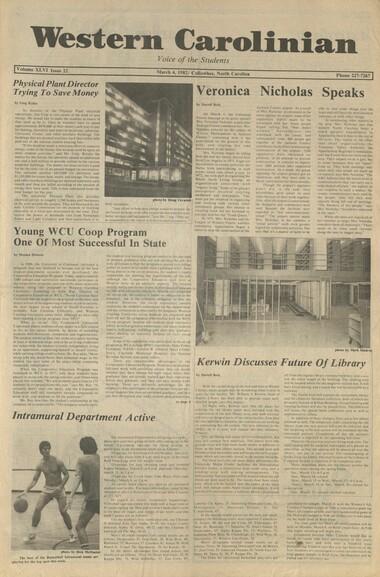

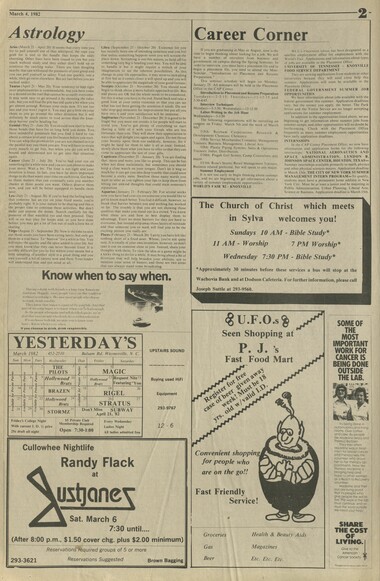
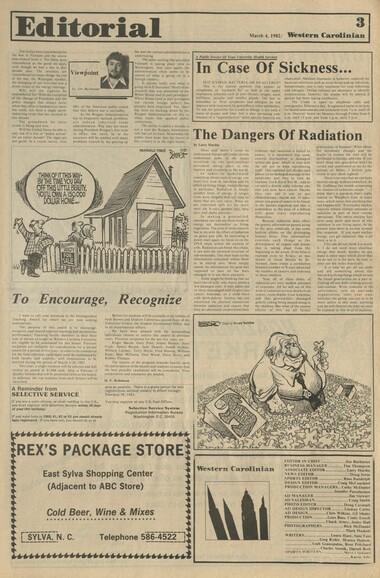
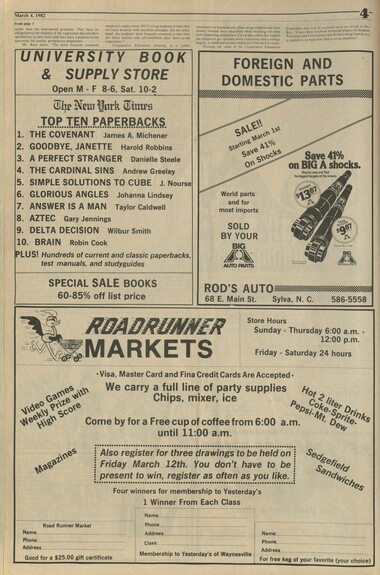
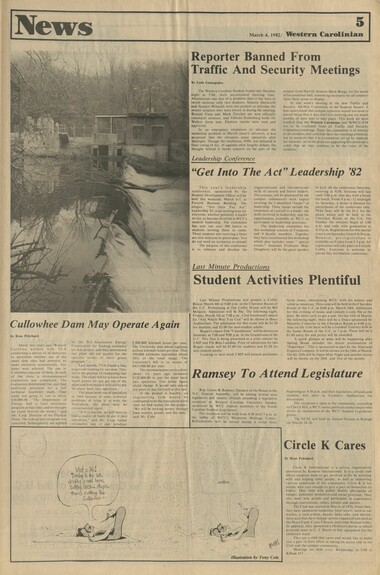
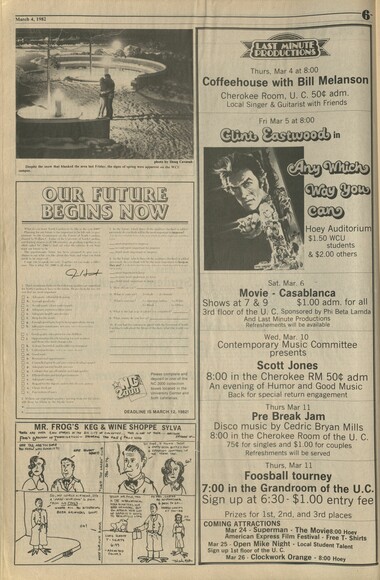
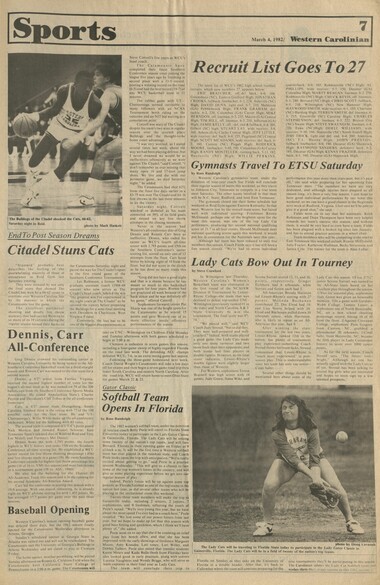
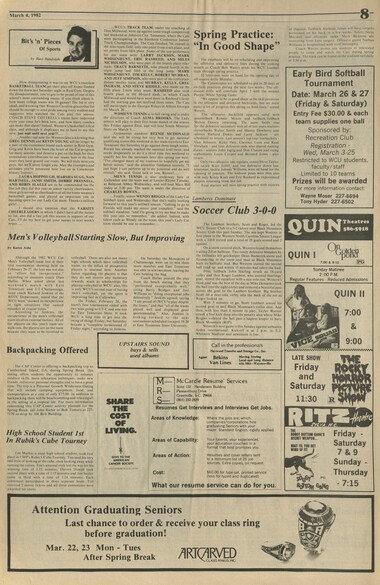
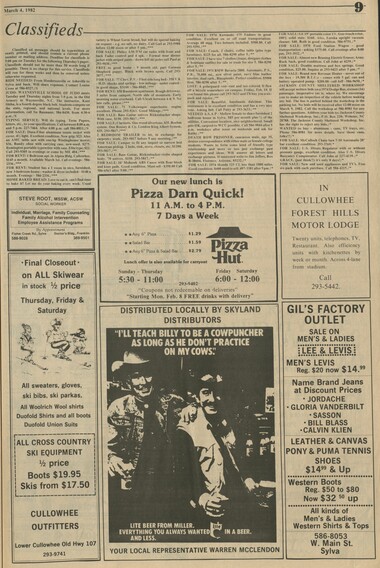
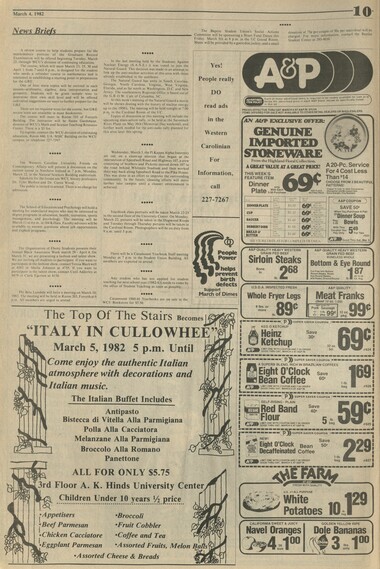
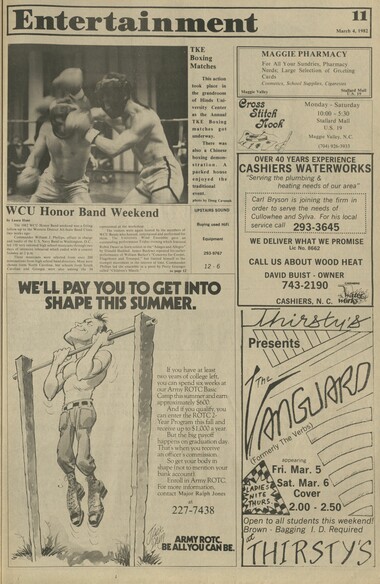
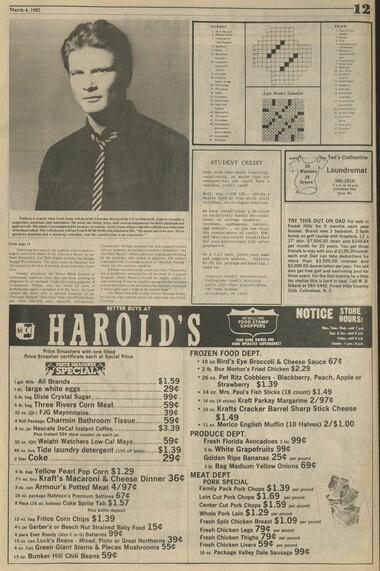
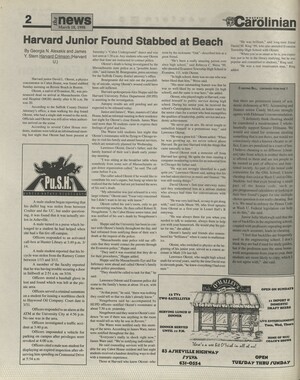
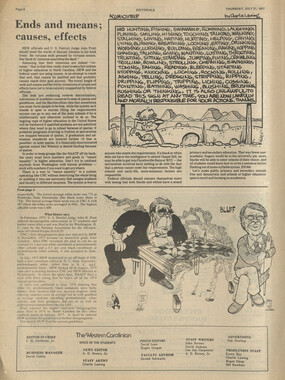

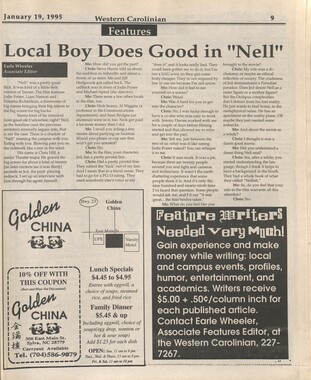
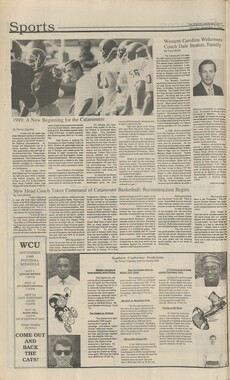
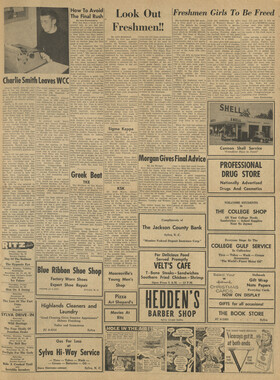
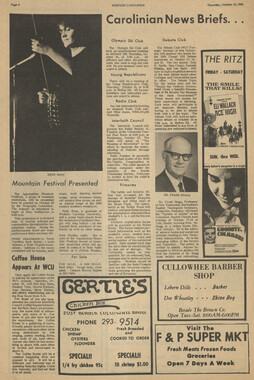
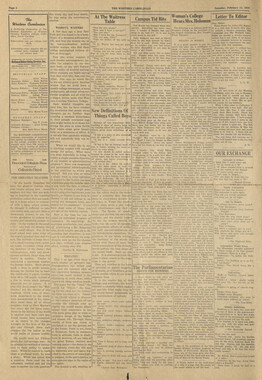
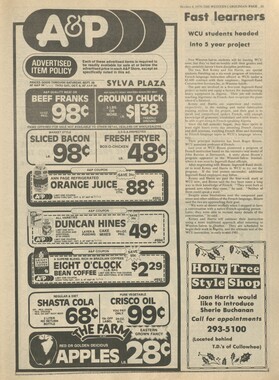
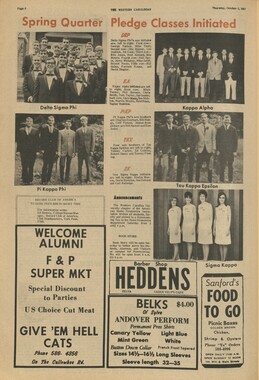
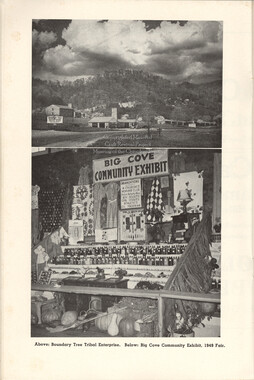

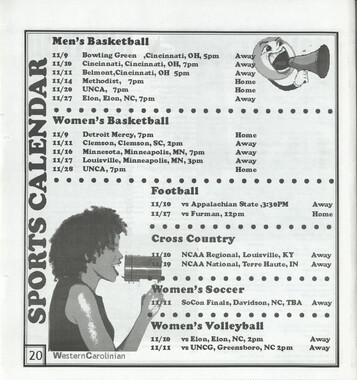
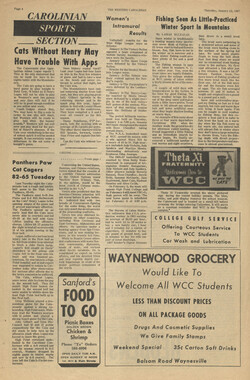
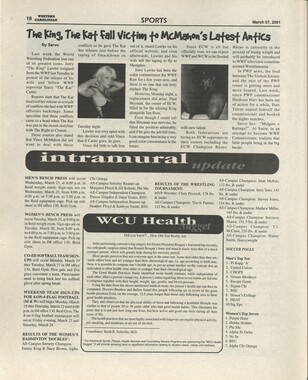
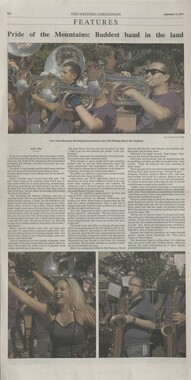
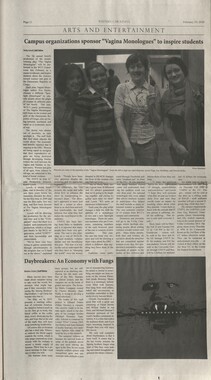
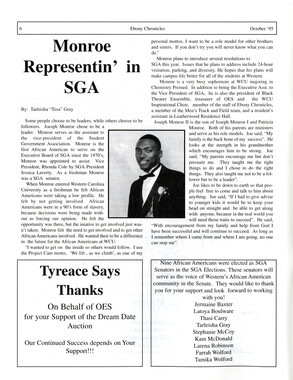
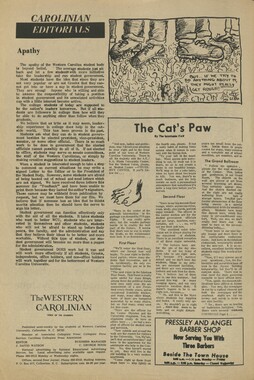
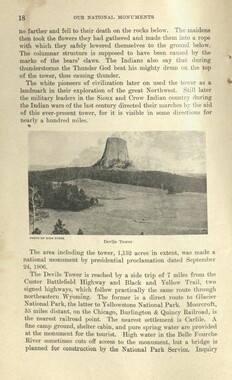
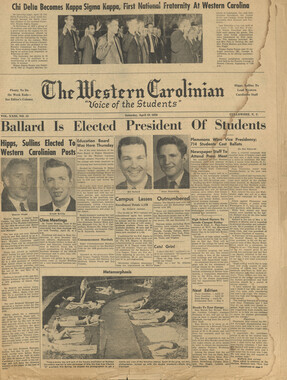
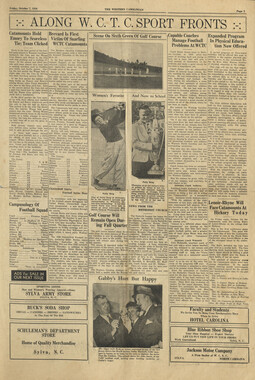
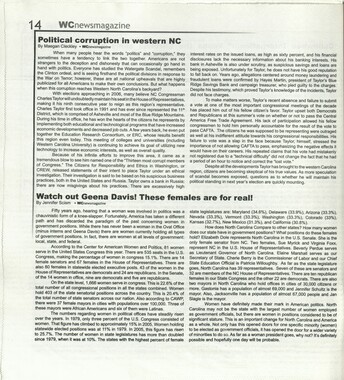
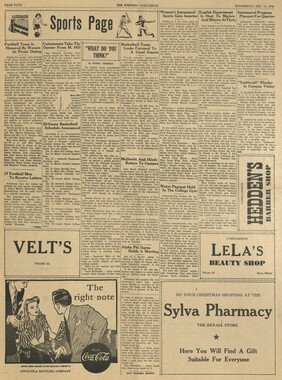
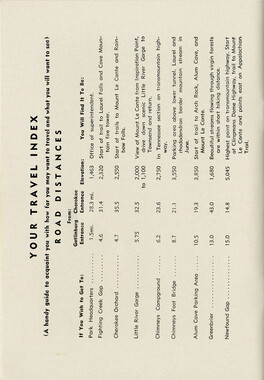
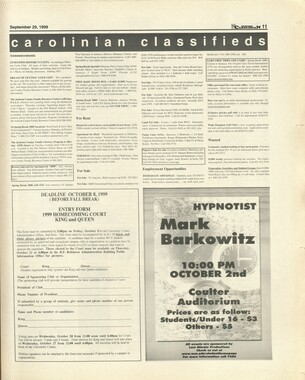
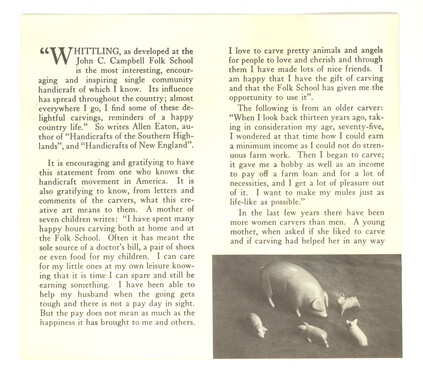
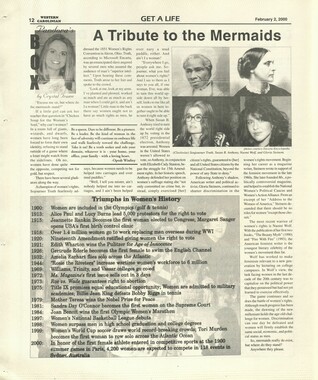

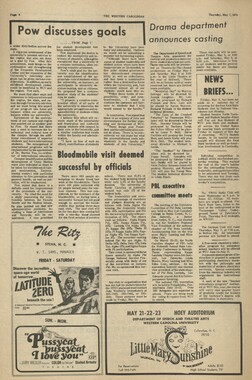
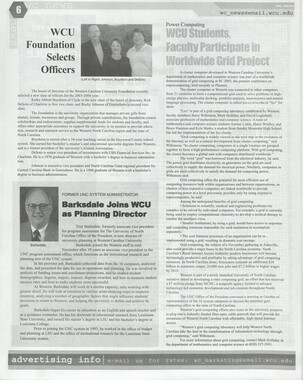
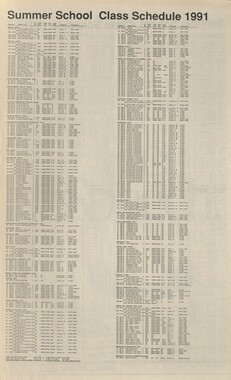
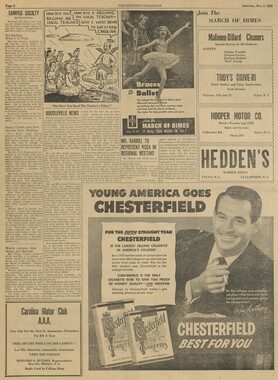

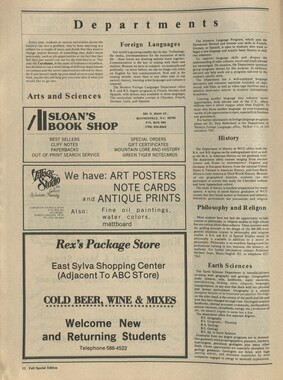
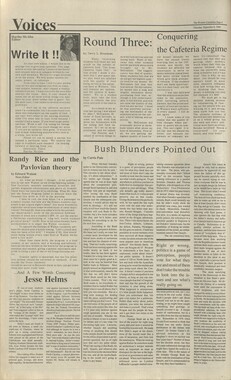

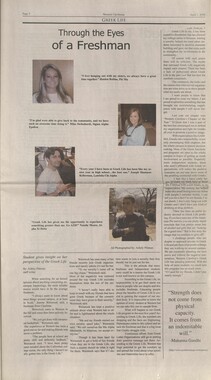



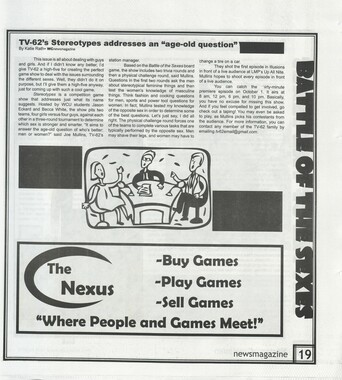
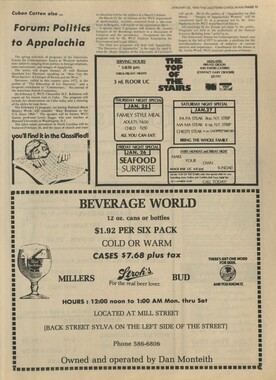


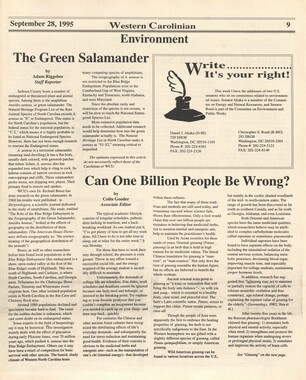
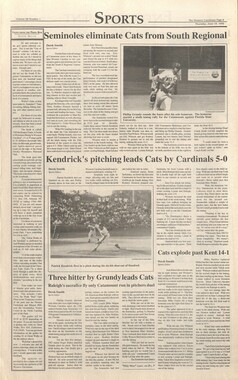


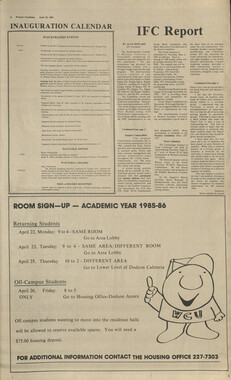


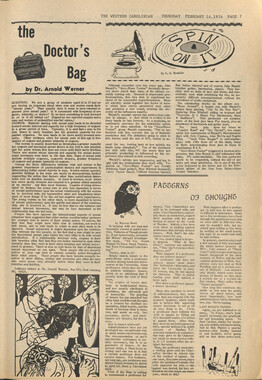


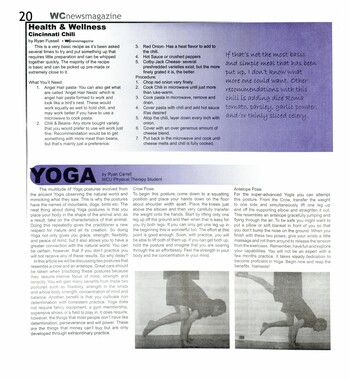

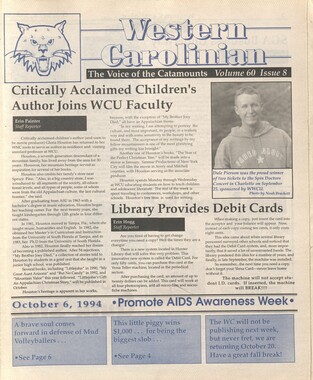


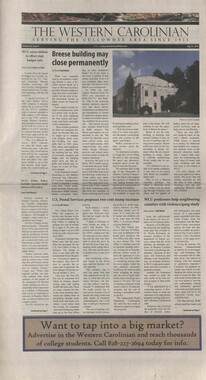
![hl_westerncarolinian_2008-09-26[10-27]_vol74_no03[04]_15.jpg](/media/w400h300/wcu_publications/hl_westerncarolinian_2008-09-26[10-27]_vol74_no03[04]_15.jpg)
